Table of contents
- Tuning special – interesting facts about carbon Black magic
- What is carbon?
- Manufacturing process
- Cleaning the mold
- Wrinkle-free insertion of the mats
- Vacuum bag
- Autoclaves
- Detach the component from the mold
- Post-treatment with belt and eccentric sander
- paint
- Uses
- Sports gloves
- Helmets
- Handlebars
- bikes
- Interview with Julius Ilmberger
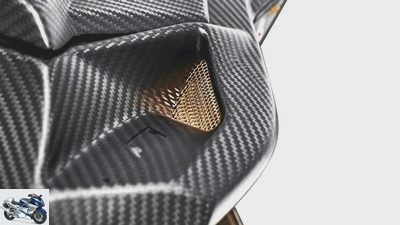
jkuenstle.de
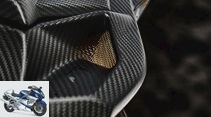
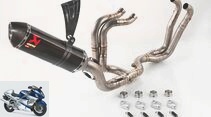

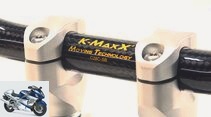
18th pictures
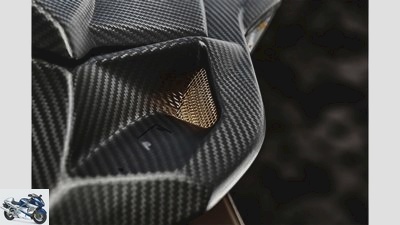
jkuenstle.de
1/18
Tuning special – interesting facts about carbon.
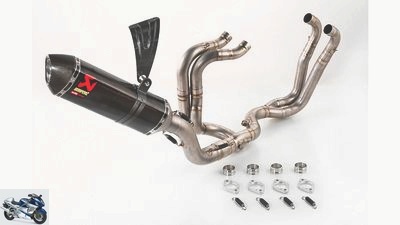
Magoga
2/18
For mufflers, the manufacturers either work entirely with carbon fiber or give the parts a layer of visible carbon.
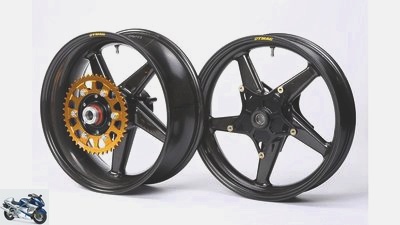
mps photo studio
3/18
Wheels made from the fine fabric are particularly exclusive. In driving tests, however, the driving stability of the bikes sometimes suffered.
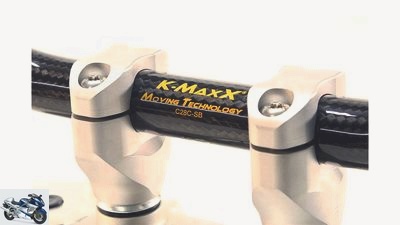
manufacturer
4/18
Too brittle as a pure carbon part. Therefore, such handlebars are made of aluminum on the inside and are decorated with carbon.
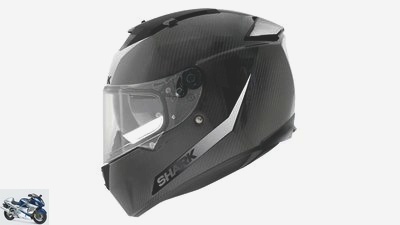
manufacturer
5/18
Most of the major helmet manufacturers now offer head protection made of carbon.
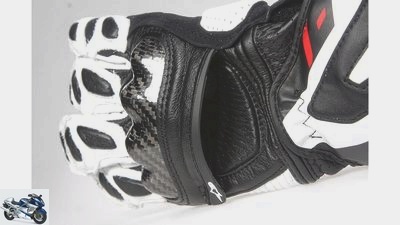
mps photo studio
6/18
Carbon insoles are popular in sports gloves. Impact tests confirmed an increased protective effect.
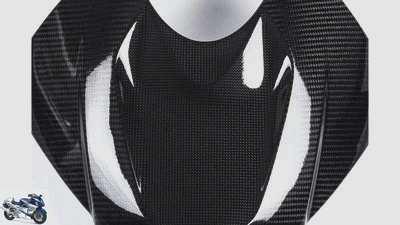
manufacturer
7/18
twill weave outside, plain weave inside.
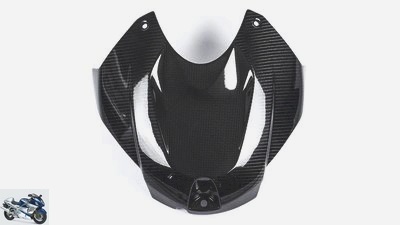
manufacturer
8/18
This tank cover has both types of carbon weave …
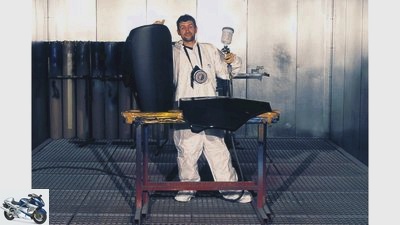
Stefan Wolf
9/18
The last step is painting – mostly with clear paint, sometimes with colored paint. Or as a combination.
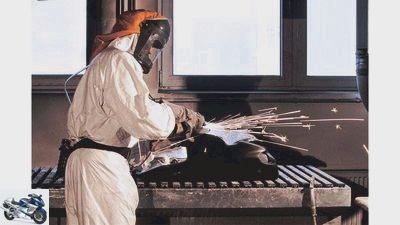
Stefan Wolf
10/18
This is followed by post-treatment with a belt and eccentric sander. An employee cuts off the protruding edges, deburrs the part and prepares it for painting. The mask provides the man with fresh air.
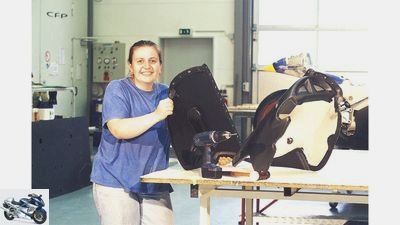
Stefan Wolf
11/18
After baking, the component is released from the mold.

Stefan Wolf
12/18
The parts are baked in the autoclave under pressure and high temperatures.

Stefan Wolf
13/18
The vacuum bag removes excess binding agent from the parts during baking.

Stefan Wolf
14/18
The workers must ensure that the mats are inserted without creases.
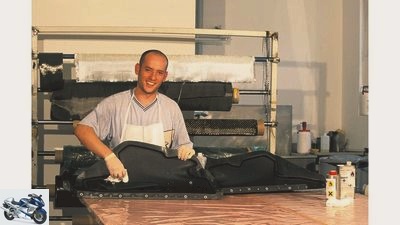
Stefan Wolf
15/18
After cleaning the mold, the blank is laid out in it.
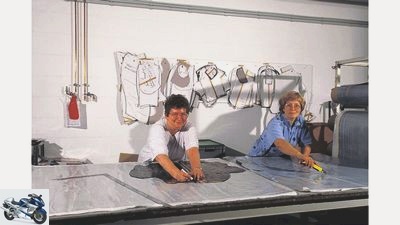
Stefan Wolf
16/18
We are guests of the company CFP Driesch in Neustadt an der Weinstrasse. There we watch the specialists in the manufacture of carbon parts. First, the pre-treated mats are cut to size.

Private
17/18
Julius Ilmberger is the owner of the Ilmberger Carbonparts company in Oberhaching near Munich. The former racer has always been fascinated by carbon and founded the company in 1990. In the PS interview, the specialist explains everything you need to know about the black, light and elegant material.
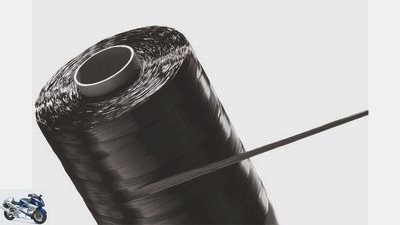
SGL Group
18/18
After winding into continuous threads, the material is woven into mats.
accesories
Tuning special – interesting facts about carbon
Tuning special – interesting facts about carbon
Black magic
Content of
Everyone knows it, everyone loves it. When it comes to reducing weight or refining your baby, there’s no getting around carbon. We tell you what you should know about the magical stuff.
Volkmar Jacob
05/12/2015
Thomas Alva Edison already worked with carbon fiber. In 1881 the famous inventor received a patent for the carbon fiber incandescent lamp he had developed with filaments made from specially treated bamboo fibers. When the threads were later made of metal, the black fabric disappeared into the sink. For the time being. Then in the fifties the revival. The aviation industry demanded light and at the same time strong material for its pilots – the starting signal for an extraordinary career. But it wasn’t until the late 1980s that carbon was discovered for motorcycles.
Buy complete article
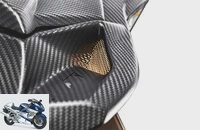
Tuning special – interesting facts about carbon
Black magic
8 pages) as PDF
€ 2.00
Buy now
Back then, however, the substance was very difficult to come by and the quality left a lot to be desired. Fortunately, things are different today. Every good accessory dealer now sells parts made of carbon, some of them of first-class quality. But how do you recognize them? And what do you have to look out for when buying? How are carbon parts actually made? And how was the raw material obtained? The following pages provide these and other answers. So that the black material does not call Green Minna on the scene, some important information beforehand: Carbon parts from the accessories must be entered in the vehicle documents. Or alternatively you have an ABE with you. Of course, that would not have happened in Edison’s time.
What is carbon?
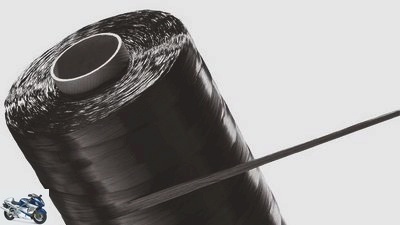
SGL Group
After winding into continuous threads, the material is woven into mats.
Carbon is a composite material made from carbon fibers and plastic. The individual fibers are obtained from carbon-containing materials in a thermo-chemical process (pyrolysis). They are six to ten times thinner than a human hair. The fibers are bundled into a continuous strand, wound up and woven into mats. The characteristic network structure is created during weaving, which does not shift against each other when subjected to stress.
As a result, it withstands high tensile forces from every direction. In addition, carbon patterns look great. Before processing, the mats are soaked in synthetic resin (impregnation or lamination) and placed in molds. The molds are placed in an oven or autoclave to harden. In the first case one speaks of “tempering”, in the second of “baking”. The hardened material is called carbon fiber reinforced plastic (CFRP) or carbon fiber reinforced plastic (CFRP). Or simply carbon.
Manufacturing process

Stefan Wolf
We are guests of the company CFP Driesch in Neustadt an der Weinstrasse. There we watch the specialists in the manufacture of carbon parts. First, the pre-treated mats are cut to size.
Cleaning the mold
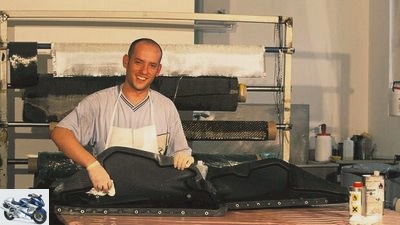
Stefan Wolf
The cleaning of the mold.
After cleaning the mold, the blank is laid out in it.
Wrinkle-free insertion of the mats
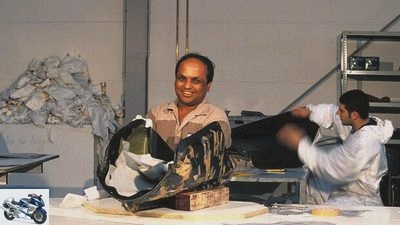
Stefan Wolf
The mats must be inserted without creases.
The workers must ensure that the mats are inserted without creases.
Vacuum bag
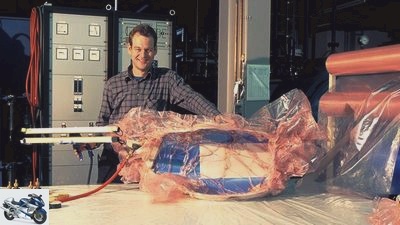
Stefan Wolf
Excess binding agents are removed from the parts.
The vacuum bag removes excess binding agent from the parts during baking.
Autoclaves
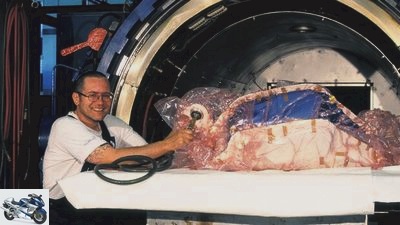
Stefan Wolf
The parts are baked in the autoclave.
The parts are baked in the autoclave under pressure and high temperatures.
Detach the component from the mold
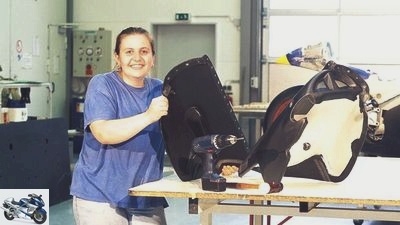
Stefan Wolf
The component is released from the mold.
After baking, the component is released from the mold.
Post-treatment with belt and eccentric sander
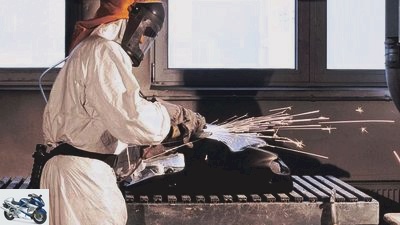
Stefan Wolf
An employee cuts off the protruding edges.
This is followed by post-treatment with a belt and eccentric sander. An employee cuts off the protruding edges, deburrs the part and prepares it for painting. The mask provides the man with fresh air.
paint
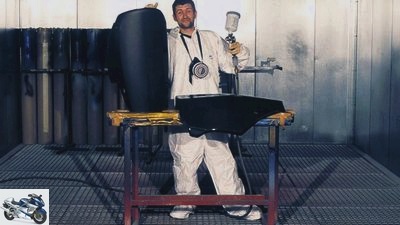
Stefan Wolf
The last step: painting.
The last step is painting – mostly with clear paint, sometimes with colored paint. Or as a combination.
Uses
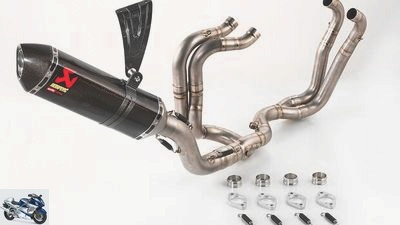
Magoga
In the case of mufflers, the manufacturers either work with carbon fiber throughout or give the parts a layer of carbon fiber.
Sports gloves
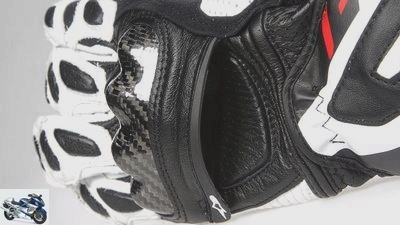
mps photo studio
Carbon inserts are often used in sports gloves.
Carbon insoles are popular in sports gloves. Impact tests confirmed an increased protective effect.
Buy gloves at markt.motorradonline.de
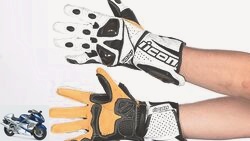
gloves
18 summer gloves for motorcyclists in the test
Never without!
read more
Helmets
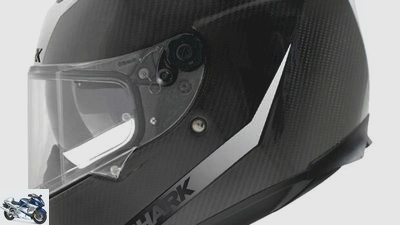
manufacturer
Shark, X-Lite, Shoei & Co. – Most of the major helmet manufacturers now have carbon helmets in their product range.
Most of the major helmet manufacturers now offer head protection made of carbon.

technology & future
Skully Fenix AR motorcycle helmet with head-up display
New CEO, new name, new opportunity?
read more
Handlebars
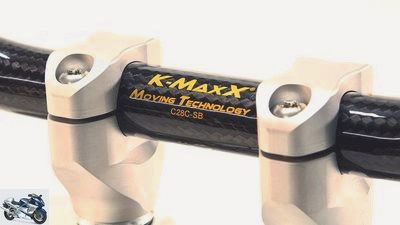
manufacturer
Handlebars are made of aluminum on the inside, but are decorated with carbon on the outside.
Too brittle as a pure carbon part. Therefore, such handlebars are made of aluminum on the inside and are decorated with carbon.
Buy handlebars on markt.motorradonline.de
PDF download PS technology special
bikes
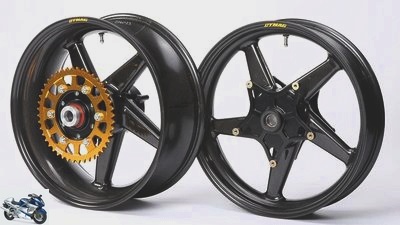
mps photo studio
Particularly exclusive: wheels made of carbon.
Wheels made from the fine fabric are particularly exclusive. In driving tests, however, the driving stability of the bikes sometimes suffered.
PDF download tire special 2014

tire
Six touring tires in a 4,000-kilometer test
Tire dimensions 120/70 ZR 17, 180/55 ZR 17
read more
Interview with Julius Ilmberger

Private
“Sometimes there are very well camouflaged inferior qualities on the market. It is not easy for laypeople to distinguish between them. “
Julius Ilmberger is the owner of the Ilmberger Carbonparts company in Oberhaching near Munich. The former racer has always been fascinated by carbon and founded the company in 1990. In the PS interview, the specialist explains everything you need to know about the black, light and elegant material.
What other advantages does carbon have besides weight savings??
Thanks to its structural design, carbon is very stable. Therefore, it does not tear as quickly as, for example, glass fiber reinforced plastic, or GRP for short. The toughness of carbon protects the underlying parts very well. In addition, the risk of the engine or frame parts being damaged in the event of a fall is much lower.
Apart from the price, what speaks against chassis parts such as frames or swingarms made of carbon?
Essentially, carbon can only be subjected to pressure or tension. It is therefore extremely important that the laminate layers are laid in certain directions to each other when assembling the parts in order to achieve the desired strength. When it comes to chassis parts, carbon behaves completely differently than aluminum or steel, so the flexibility of the frame or swing arm, which is sometimes desired, changes significantly. Therefore, such parts cannot simply be exchanged and made from carbon. But there are motorcycle frames made of carbon that work great.
If you look closely, you will notice different patterns in carbon parts. How come?
Carbon mats are woven in two ways: twill and plain weave. They differ slightly in terms of tensile strength, but this is negligible. In addition to canvas and twill weave, a distinction is also made between grams. This then indicates the size and width of the woven strands of thread. The accessory parts manufacture mostly uses twill or canvas.
How are the mats processed further? There are different procedures?
A basic distinction is made between wet lamination and the use of so-called prepreg mats. In the first case, the mats are soaked in resin shortly before processing and placed in a mold. The mold is then placed in an ordinary oven to dry at around 50 degrees. This is what I call annealing. If implemented correctly, this method delivers decent visual results. However, it does not achieve the high rigidity and stability that is achieved when baking in an autoclave. In addition, wet laminates cannot be painted so well because of their poor surface quality, air and resin inclusions. In some cases, manufacturers also work with press technology. The fabric is pressed into the mold with a stamp. Except for this difference, the process corresponds to wet lamination – with the same disadvantages. The use of prepreg mats (prepreg = “preimpregnatet fibers”, in English: pre-impregnated fibers, the Red.), On the other hand, guarantees a consistently low proportion of binding agents, as they are manufactured by machine. As a result, the components are very dimensionally stable and have a clearly defined stability.
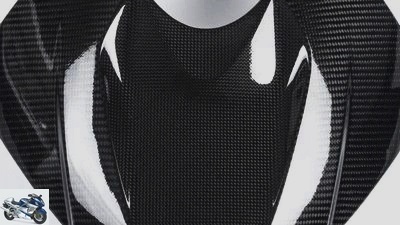
manufacturer
This tank cover has both types of carbon weave: twill weave on the outside, plain weave on the inside.
Do prepreg mats still have to be re-laminated? And they don’t harden by themselves over time?
Prepreg carbon mats already contain the necessary binders and no longer need to be soaked with resin or the like, as was previously the case or with wet laminates. Depending on the type of application, we use different prepreg fabrics with different temperature resistance and different curing temperatures and times. Prepreg fabric needs to be baked to cure. But you should process it within a certain period of time, otherwise it will be unusable.
You mentioned the autoclave before when it came to processing. What is that exactly?
An autoclave is a gas-tight, sealable pressure vessel in which parts are baked under pressure and at high temperatures.
What is the advantage of this method?
Because of the overpressure, the fabric is pressed more strongly into the mold, whereby the individual laminate layers are more strongly connected to one another. This makes the parts much more stable than with layers that are only freely superimposed. In addition, the parts manufactured in the autoclave retain their strength and do not become soft. In the case of wet laminates, this can happen when they are heated, for example by exposure to sunlight.
What pressure and what temperatures prevail in an autoclave?
Please understand that we cannot provide any precise information on this. But an autoclave usually works with up to 10 bar pressure at a temperature of up to 250 degrees. However, these limit values do not have to be reached with prepreg technology.
Before baking in the autoclave, the parts are packed in vacuum bags. Why is that necessary?
Constant suction creates a certain negative pressure in the sack. This removes the excess binding agent from the parts. Too much binding agent and resin disturb the stability of carbon. Therefore, only a predetermined amount should remain in the component.
Why are you using molds made from CNC machined aluminum?
Aluminum molds are very cost-intensive to produce, but offer the advantage that they practically do not wear out and guarantee a constant quality of the components. Molds made of special CFRP are possible without any problems, but unfortunately they have a very limited service life and wear out a lot.
The more stable a component has to be, the more layers it logically needs. But how many layers does the side panel of a super sports car consist of, for example??
There is no general answer to this question. The number of layers depends on the area. Surfaces that are particularly at risk of falling or subject to high loads can also have five or six layers. While one or two layers may be sufficient in other areas.
How does the layman recognize high-quality carbon parts?
The differentiation may not be easy for laypeople, because there are sometimes very well camouflaged inferior qualities. High-quality carbon parts are inherently very stable and can only be deformed with great difficulty in relation to their strength and weight. Wet laminates can be recognized by their surface. On closer inspection, there are many small micro-holes. There are also numerous wet laminate parts on the market that have already been coated with clear varnish. But they are relatively heavy due to the many layers of paint. As mentioned, wet laminates also become soft when heated.
In some cases, GRP parts are covered with a carbon fiber mat. In the installed state, however, it is difficult to distinguish from real carbon parts, right??
That’s correct. Since in such cases only the top layer is usually made of carbon, the GRP structure can be clearly seen on the inside. Even if it is colored black. In addition, such mixed parts are usually very unstable. They can be distinguished from real carbon fiber parts by simply pressing the surface. Parts made entirely of carbon also have the typical structure on the inside. However, it looks a little different than on the surface.
Your company uses powder coating as a seal. Why don’t you work with spray paint?
The plastic coating of carbon parts is not the usual standard. As a rule, if at all, only spray-on clearcoat is used. Our plastic coating looks similar to thin clear lacquer, but surpasses it considerably in terms of stability and scratch resistance. We have proven the increased protection against scratches and UV light. Often completely unpainted, only polished parts are offered on the market.
Your company enjoys a first-class reputation in the scene and, according to its own statements, leads internationally with its carbon products. How high is unrisk the market share in percent?
We are active in many different areas. Therefore it is rather difficult to speculate about market shares.
Related articles
-
accesories Service special brakes Service special brakes Technology brake discs Ceramic brake discs are the latest hit. MOTORRAD had the opportunity to…
-
Suspension special: Part 9 – Strut tuning
Jahn accesories landing gear & Spring elements Suspension special: Part 9 – Strut tuning Suspension special: strut tuning What good is the conversion of…
-
Suspension special: Part 8 – fork tuning
Jahn accesories landing gear & Spring elements Suspension special: Part 8 – fork tuning Suspension special: fork tuning What are the real benefits of…
-
Conversion and tuning guide optical tuning Suzuki GSX-S 1000 1-2
Ines Mannl 21 pictures triplespeed headquarters / Ines Mannl 1/21 How it all started: With a standard Suzuki GSX-S 1000. Technically first class, the…
-
BMW Motorrad: New aluminum frame with carbon reinforcements
BMW. 4th pictures BMW motorcycle 1/4 BMW Motorrad would like to add stiffening elements made of composite materials to a standard aluminum frame. The…
-
jkuenstle.de 15th pictures manufacturer 1/15 There are many wearing parts in a brake system. First and foremost, these are the pads, brake fluid and the…
-
Tuning special – exhaust systems
Akrapovic 6th pictures Akrapovic. 1/6 Akrapovic has its own exhaust gas laboratory and its own titanium foundry for the direct implementation of new…
-
TuneUp 2.0 Tuning and Conversion Guide Honda Fireblade
Ines Mannl 17th pictures Ines Mannl 1/17 Don’t worry, it has to be that way! Even if this Honda is not ready to drive, it all serves a higher goal!…
-
PS-Tune Up special tips for screwing
23 pictures archive 1/23 Above: ideal case – 90 degree position. Bad posture like in the two pictures below can be prevented by adjustable footrests….
-
MV Agusta F4 Claudio special model
MV Agusta 34 pictures MV Agusta 1/34 MV Agusta has launched a new special model. MV Agusta 2/34 The special model is called Claudio and pays homage to…